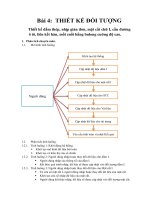Decorator (THIẾT kế đối TƯỢNG SLIDE)
Bạn đang xem bản rút gọn của tài liệu. Xem và tải ngay bản đầy đủ của tài liệu tại đây (419.04 KB, 33 trang )
Decorator Pattern
1
Welcome to Starbuzz Coffee!
•
•
Starbuzz Coffee has made a name for itself as the fastest growing coffee shop.
Because they have grown so quickly, they are scrambling to update their ordering system
to match their beverage offerings….
2
Various types of BCOFFEE
•
Beverage price
–
–
–
–
•
HouseBlend: $ 0.89
Decaf: $ 1.05
Espresso: $ 1.989
DarkRoast: $ 0.99
Condiment price
–
–
–
–
Milk: $ 0.10
Soy: $ 0.15
Mocha: $ 0.20
Whip: $ 0.10
3
The First Design of the Coffee Shop
Beverage
is
an
abstract
class,
Beverage
subclassed by all beverages offered in the
coffee shop.
- description
The cost() method is abstract. Subclasses need to
+ getDescription()
define their own implementations.
+ cost()
// other useful methods
HouseBlend
+ cost()
DarkRoast
+ cost()
Decaf
+ cost()
Expresso
+ cost()
Each subclass implements cost() to return the cost of the beverage
4
Adding on …
In addition to your coffee you can also ask for several condiments like steamed milk, soy,
mocha, …
Starbuzz charges a bit for each of these so they really need to get them built into the order
system.
Beverage
First attempt …
- description
+ getDescription()
Can you say
Each cost() method computes the cost of the coffee
+ cost()
“Class Explosion” !!!!
// other useful methods
HouseBlend
DarkRoast
HouseBlendWithSteamedMilkandMocha
+ cost()
along with other condiments in the order.
Decaf
Expresso
DarkRoastWithSteamedMilkAndMocha
+ cost()
+ cost()
+ cost()
+ cost()
+ cost()
DarkRoastWithWhip
+ cost()
DarkRoastWithSteamedMilk
+ cost()
HouseBlendWithSteamedMilk
DecafWithSteamedMilkAndMocha
+ cost()
ExpressoWithWhipandSoy
+ cost()
DarkRoastWithSoyAndMocha
+ cost()
+ cost()
5
Question
•
It is pretty obvious that Starbuzz has created a maintenance nightmare for themselves.
•
What happens when the price of milk goes up?
Or when they add a new caramel topping?
•
What OO design principle(s) are they violating here?
–
–
Encapsulate what varies
Program through an Interface
not to an Implementation
–
Favor Composition over Inheritance
6
Alternatives to the Design?
Beverage
We add instance variables to represent whether or not each beverage
- description : String
has milk, soy, mocha and whip ...
- milk : boolean
- soy : boolean
- mocha : boolean
- whip : boolean
implement cost() in Beverage that calculate the costs associated with the
+ getDescription()
These get and set the boolean
values for the condiments.
condiments for a particular beverage instance.
+ cost()
+ hasMillk()
+ setMillk()
+ hasSoy()
+ setSoy()
Subclasses will still override cost(), but they
// other
will also invoke the super version so that they
can calculate the total cost of the basic beverage
plus the costs of the added condiments.
HouseBlend
+ cost()
DarkRoast
+ cost()
Decaf
+ cost()
Expresso
+ cost()
7
Sharpen your pencil
•
Write cost() method for the following classes:
p u b lic class Beverage {
p u b lic class D arkRoast
...
exten d s Beverage {
p u b lic d ou b le cost() {
p u b lic D arkRoast() {
description =
d ou b le sum = 0;
"M ore excellent D ark Roast";
if hasM ilk() sum + = 0.1;
}
if hasSoy() sum + = 0.15;
if hasM ocha() sum + = 0.2;
p u b lic d ou b le cost() {
if hasW hip() sum + = 0.1;
retu rn 0.99 + su p er.cost();
retu rn sum ;
}
}
}
}
8
Is this ok?
What requirements or other factors might change that will impact this design?
1)
2)
3)
4)
•)
Price changes for condiments will force us to alter the existing code
New condiments will force us to add new methods and alter the cost method in the
superclass.
New beverages like iced tea. The iced tee class will still inherit the methods like
hasWhip().
What if a customer wants a double mocha?
What else?
9
The Open-Closed Principle
Classes should be open for extension, but closed for modification.
•
Our goal is to allow classes to be easily extended to incorporate new behavior without
modifying existing code.
•
What do we get if we accomplish this?
–
Designs that are resilient to change and flexible enough to take on new functionality to meet
changing requirements.
10
Meet the Decorator Pattern
•
Decorating Coffee: We start with a beverage and “decorate” it with the condiments at
runtime.
•
If a customer wants a Dark Roast with Mocha and Whip, we do the following:
–
–
–
–
Take a DarkRoast object
Decorate it with a Mocha object
Decorate it with a Whip object
Call the cost() method and rely on delegation to add on the condiment costs.
How do you “decorate”
and how does delegation come into this?
11
Constructing a drink order with Decorators
DarkRoast inherits from Beverage and has a
1.
Start with the DarkRoast object
cost()
cost() method that computes the cost of the
drink.
DarkRoast
2.
Customer wants Mocha, so we create a Mocha object and wrap it around the DarkRoast.
cost()
The Mocha object is a “decorator”. Its type mirrors the object it is decorating, in this case, a
cost()
Beverage.
DarkRoast
3. The customer
wants Whip, so we create a Whip decorator and wrap Mocha with it.
Mochalso
a
cost()
cost()
Whip
cost()
DarkRoast
Mocha
Whip is a decorator, so it also mirrors DarkRoast’s type and includes a cost() method.
12
Constructing a drink order with Decorators
4.
Compute the cost for the customer.
–
Do this by calling cost() on the outermost decorator, Whip,
and Whip is going to delegate computing cost to the objects it decorates. Once it gets a cost,
it will add on the cost of the Whip.
(2) Whip calls cost() on
(1) First we call cost() on the outermost decorator
Mocha
(3) Mocha calls cost() on
Whip.
DarkRoast
cost()
1.29
cost()
cost()
1.19
DarkRoast
0.99
(4) DarkRoast returns its cost, 99
cents
(6) Whip adds its total, 10 cents, to the result from
Mocha, and returns the final result -- $1.29.
(5) Mocha adds its cost, 20 cents, to the result and returns the new
total $1.19
13
So what do we know so far?
•
Decorators have the same supertype as the objects that they decorate.
•
You can use one or more decorators to wrap an object.
•
Given that the decorator has the same supertype as the object it decorates, we can pass around
a decorated object in place of the original object.
•
The decorator adds its own behavior either before and/or after delegating to the object its
decorates to do the job.
•
Objects can be decorated at any time, so we can decorate objects at runtime with as many
decorators as we like.
Key point!
14
Decorator Pattern Defined
The Decorator Pattern attaches additional responsibilities to an object dynamically. Decorators provide a flexible
alternative to subclassing for extending functionality.
Component
defines the interface for objects that can
have
responsibilities
added
to
them
+ methodA()
dynamically.
+ methodB()
+ other methods()
maintains a reference to a Component object
and implement the same interface as the
component they are going to decorate.
defines an object to which
ConcreteComponent
Decorator
- wrappedObject : Component
additional responsibilities
can be attached.
+ methodA()
+ methodA()
+ methodB()
+ methodB()
+ other methods()
+ other methods()
Decorators can adds responsibilities
ConcreteDecoratorA
to the component.
can extend the state of the
ConcreteDecoratorB
component
- newState : Object
+ methodA()
+ methodB()
+ other methods()
+ methodA()
+ methodB()
+ other methods()
15
Decorate the Beverages!
Beverage acts as our abstract Component class
Beverage
- description
+ getDescription()
+ cost()
// other
HouseBlend
CondimentDecorator
DarkRoast
# beverage : Beverage
+ cost()
+ cost()
Decaf
+ cost()
+ getDescription()
Expresso
+ cost()
The four concrete components, one per coffee type.
Milk
Mocha
+ getDescription()
+ getDescription()
+ cost()
+ cost()
Whip
The condiment decorators.
Notice they need to implement the cost() as well as the
getDescription().
Soy
+ getDescription()
+ getDescription()
+ cost()
+ cost()
16
Some Real Code!
public abstract class Beverage {
protected String description = "Unknown Beverage";
public String getDescription() {
Beverage is an abstract class.
return description;
getDescription() method is already implemented, but we need to
}
implement cost() method in the subclasses.
public abstract double cost();
}
we need to be interchangeable with Beverage, so we extend the Beverage
class.
public abstract class CondimentDecorator extends Beverage {
protected Beverage beverage;
public CondimentDecorator (Beverage beverage) {
this.beverage = beverage;
}
require that the condiment decorators
reimplement the getDescription() method.
public abstract String getDescription();
}
17
Coding Beverages
public class DarkRoast extends Beverage {
public DarkRoast() {
description = "Dark Roast Coffee";
}
public double cost() {
return .99;
}
}
public class Espresso extends Beverage {
public Espresso() {
description = "Espresso";
}
public double cost() {
return 1.99;
}
}
18
Coding Condiments
public class Mocha extends CondimentDecorator {
public Mocha(Beverage beverage) {
super(beverage);
We want our description to say not only DarkRoast -- but to also
include the item decorating each beverage for instance:
}
DarkRoast, Mocha.
public String getDescription() {
return beverage.getDescription() + ", Mocha";
}
public double cost() {
return .20 + beverage.cost();
}
}
Similarly, to compute the cost of the beverage with Mocha, we first delegate to the
object that is being decorated, so that we can compute its cost and then add in the
cost of the Mocha.
19
Ordering Coffee
public class StarbuzzCoffee {
public static void main(String args[]) {
Beverage beverage1 = new Espresso();
System.out.println(beverage.getDescription()
+ " $" + beverage.cost());
Beverage beverage2 = new DarkRoast();
beverage2 = new Mocha(beverage2);
beverage2 = new Mocha(beverage2);
beverage2 = new Whip(beverage2);
System.out.println(beverage2.getDescription()
+ " $" + beverage2.cost());
}
}
Output:
Espresso $1.99
Dark Roast Coffee, Mocha, Mocha, Whip $1.49
20
Real World Decorators
•
The java.io package uses the Decorator pattern!
Heres the abstract component
InputStream
FilterInputStream is an abstract
decorator
FileInputStream
StringBufferInputStream
PushbackInputStream
These InputStreams are the
ByteArrayInputStream
FilterInputStream
DataInputStream
LineNumberInputStream
BufferedInputStream
ConcreteComponents.
There are a few more that are not shown here.
Here are the concrete decorators.
21
The java.io Package (contd.)
•
What is the typical set of objects that use decorators to add functionality to reading data
from a file?
1001
1110100
A Text File
001010
LineNumberInputStream is a concrete
1010111
decorator.
It adds the ability to count the line numbers
as it reads data.
FileInputStream
BufferedInputStream
FileInputStream is the component that’s being decorated. The
LineNumberInputStream
BufferedInputStream is a concrete Decorator. BufferedInputStream
adds behavior in two ways: it buffers input to improve performance, and also
augments the interface with a new method readLine() for reading
Java
I/O
library
supplies
several
components,
including
FileInputStream, StringBufferInputStream, and others. All
of these give us the base component from which to read bytes.
character-based input, a line at a time.
22
Exercise your brains…
•
How would you write a decorator that converts all uppercase characters to lowercase in the
input stream?
23
Writing your own Java I/O Decorator
public class LowerCaseInputStream
extends FilterInputStream {
extend the FilterInputStream abstract decorator for all
InputStreams
public LowerCaseInputStream(InputStream in) {
super(in);
implement two read methods.
}
They take a byte (or an array of bytes) and convert
public int read() throws IOException {
each byte to lowercase.
int c = super.read();
return (c == -1 ? c : Character.toLowerCase((char)c));
}
public int read(byte[] b, int offset, int len)
throws IOException {
int result = super.read(b, offset, len);
for (int i = offset; i < offset+result; i++) {
b[i] = (byte)Character.toLowerCase((char)b[i]);
}
return result;
}
}
24
Test out your new Java I/O Decorator
public class InputTest {
public static void main(String[] args) throws IOException {
int c;
Set up the FileInputStream and decorate it, first with a
try {
BufferedInputStream and then our brand new LowerCaseInputStream filter.
InputStream in =
new LowerCaseInputStream(
new BufferedInputStream(
new FileInputStream("test.txt")));
while((c = in.read()) >= 0) {
System.out.print((char)c);
}
in.close();
} catch (IOException e) {
e.printStackTrace();
}
}
}
25









